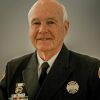I travel more than most, and usually like to visit a fire station near where I am staying to talk shop and learn a bit more about the local area. But on one of my most recent trips, I honestly had a hard time finding the closest fire station in a fairly affluent part of the country. There were certainly no issues finding a golf course – in fact, the area where I was staying probably had three or four within a two-mile radius of my hotel – but finding the local fire station was a different matter.
As I traveled down the six-lane highway that traversed most of this major city, I saw no indication of the fire department’s presence. Traveling on a smaller four-lane cross street, I finally spotted a yellow diamond universal traffic sign with the image of a fire truck, signifying that a station had to be near.
While I slowed and looked both up and down the side street, I still couldn’t find the station – even when I looked for other signs, such as a flag pole or caution lights that might reveal its location. I knew this city had career firefighter/paramedics so it made this quest even more puzzling. Finally, I spotted a fire truck at a shopping center grocery store, and stopped to introduce myself and ask where the station might be, and if I could stop in to visit.
It turned out that I’d passed the non-descript building that served as the nearest fire station several times, thinking it was a small service garage. Nothing visibly identified it as the fire department amidst the gaggle of retail businesses that lined the main thoroughfare or the gated communities along the side streets.
It appeared that this city intentionally kept its safety services in low profile. In fact, the only time I saw a marked police cruiser was while passing a rear-end collision on the same highway. The fire department had also responded with a staff vehicle, an engine and a medic unit.
The city’s attitude toward the fire service reminded me of an old poster that once showed a firefighter in full PPE crammed into an oversized fire extinguisher cabinet with the slogan, “In case of fire, break glass.” It seemed the norm for this city was for the fire department to be seen when needed, but otherwise operate in stealth mode, on the assumption their presence would upset the residents.
It was also obvious that this community wanted to project an image to its citizens, visitors and businesses that nothing bad ever happened there. But realistically, does such an approach allow the fire department to reach its full potential or utilize its full capacity?
Community paramedicine and outreach
We as firefighters do more than extinguish fires or provide advanced life support. We provide a myriad of other services both in emergency response and in community risk reduction. When we are resigned to appear invisible, it cheats the public out of services they deserve and expect in other communities.
For example, visible fire departments can help older citizens with a home fall prevention assessment that would help them continue to live within their existing residence; or provide them with a “Vial of Life” or similar device that lists their medical conditions and current medications for us to use in the event they are alone and incapacitated at home.
Community paramedicine, is another example, providing proactive health services, not just the traditional emergency medical service, through partnerships with other agencies including such non-governmental organizations as Meals On Wheels, Senior Services and the American Red Cross.
In some areas of the country, these partnerships include healthcare systems, especially in rural areas or in those communities currently underserved by licensed medical facilities. If you want to imagine our future roles as firefighter/paramedics, you need only to look at the advertisement from a national cell phone provider that discusses how their future cell coverage network will soon allow robotic surgery by a distant physician being conducted on a patient in the back of paramedic transport unit. Such intervention in the near future is not out of the question in time-critical cases.
These types of additional services can only be introduced when firefighters are allowed to be visible, interact with and inform the public. Today’s fire service needs to be pro-active within the communities they serve and that productivity requires visibility and direct contact with its citizens.
Like it or not, today’s fire service will continue to constantly evolve. From today’s home smoke detector inspections and new installations when needed, to front-line opiate addiction intervention, the fire service is the trusted, tested and respected emergency service welcomed into most every home in the United States without hesitation. We have earned that respect over our nearly 250 years of professional, dedicated service. Our purpose remains to be there to help our citizens on the worst day of their lives. It is our responsibility to keep their trust well into the future, whatever new roles that may bring.
Stay safe!


